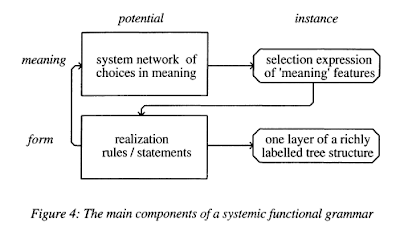Fawcett (2010: 172):
As we saw in Chapter 3 — and most clearly in Figure 4 in Section 3.2 of that chapter — any adequate theory of language must provide, for each level of language, for both the potential and the instances of that potential. In some theories of language, of course, it is assumed that it is precisely the task of the theory of the potential (the grammar) to specify the instances that can be generated from the potential (the sentences of the language). But I have argued — both in Section 6.5 of Chapter 6 and more fully in Fawcett (1994a) — that, if we want a theory that can be used for modelling both the understanding and the generation of language texts, we need to recognise that we require a different set of concepts when faced with the task of analysing an incoming string of words (i.e., parsing) from those that are needed when we are trying to model the grammar in use for generation. In the process of generation there is no equivalent of the problematical task of parsing, as is demonstrated in Fawcett (1994a).
Blogger Comments:
[1] Reminder:
To be clear, Fawcett's model misconstrues instantiation as a relation between system and selection expression, at the level of meaning, and a relation between realisation rules and structure, at the level of form. As explained in many previous posts, a selection expression can be viewed as potential or instance, as shown by the phonological selection expression [voiced, bilabial, stop], which is synthetically realised by the phoneme /b/, whether as potential or as instance. As also explained in many previous posts, the relation between realisation rules and structure is the relation between the paradigmatic and syntagmatic axes: realisation, not instantiation.
[2] To be clear, both the grammar and 'the sentences of language' can be viewed as potential or instance. For example, 'the sentences of language' can be viewed as potential (grammatical systems) or as instances (in texts). It appears that Fawcett misunderstands 'instance' to simply mean 'output'.
[3] To be clear, in SFL Theory, the system is both the means by which speakers make meaning and the means by which addressees understand it. The different requirements of text generation and text parsing derive from trying to accommodate the fact that computers are not humans. A theory of language models the language of humans; a model of text generation and parsing by computers is not a model of human language.

No comments:
Post a Comment